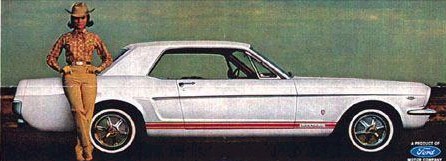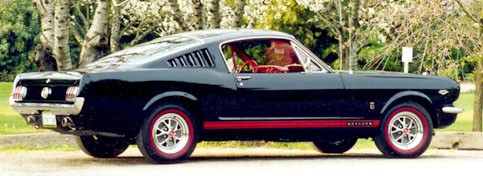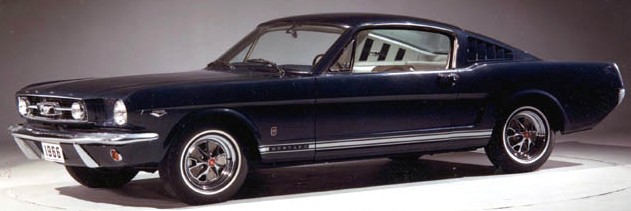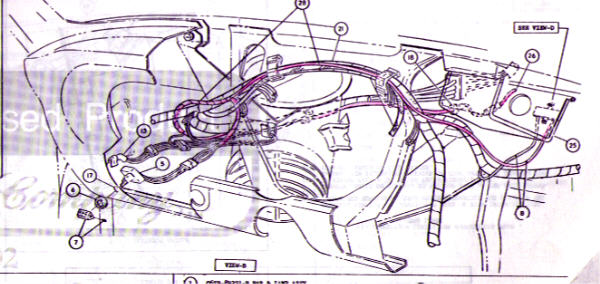
Identifying the True Factory GT for
1965 and 1966 Mustangs
Even with all the web pages out there that address this topic they are mostly incorrect! What I am trying to do is create the most comprehensive page on the web for this subject. I will update it as necessary if more information becomes available or if information proves incorrect. Let me know if you have information that disputes or confirms what I have stated on this page. mailto:admin@kcode.net Newer updates are highlighted in green

1.
The VIN needs to have either an A code or K code in the 5th position.
Transmission doesn't matter it could be manual or automatic (the engine
code is the 5th character in the VIN on Mustangs). The build date should
be sometime after mi
2. There are special reinforcements for dual exhaust both under the rear seat and in the rear frame rails. Also the rear brake line hose bracket was relocated more to the left to allow for the dual exhaust. This is also true for the "K" High Performance Mustangs and all factory optioned dual exhaust Mustangs.
3. All GTs received ornamental trumpet exhaust tips exiting through a special rear valance with trim rings.
4. The factory GT received a special handling package which included a faster steering box 16:1 ratio Tag: HCC-AX (MS) or HCC-AW (PS) , larger sway bar (13/16" diameter) ,stiffer front coils and rear springs (front coils approx 8.25 coils, 1413 lb or 1491 lb rear springs four leaf design 610 lb or 650 lb )and heavy duty shock absorbers This is also true for the "K" High Performance Mustangs and all Mustangs that had the optional special handling package.
5. The factory GT received front disc brakes which included a larger single master cylinder and a special proportional valve The brake pedal also had "Disc Brakes" on it.
6. The factory GT received fog lights with horizontal bars and they received at least one hole in the radiator support. They also received fog light wiring, circuit breaker and a fog light switch.
7. Factory GT cars received special stripes on the lower fender, doors and rear quarter panel. They also received M U S T A N G letters and GT badges. The rocker panel molding were deleted as well as the rear scoop ornamentation (coupe and convertible only, fastbacks always had rear scoop ornamentation deleted). Some people have told me that the scoop ornamentation and rocker panel moldings could be special ordered. But they were most likely only a dealer install on GTs and very rare if true.
8. Standard Mustang emblems were deleted from front fenders.
9. Rear bumper guards were deleted from rear valance to make room for the exhaust trim and trumpets
Update: Additionally, the bracket bolt holes were sealed with small plugs.
The 1965 Mustang GT is a unique beast and the hardest to fake. Let me state the unique aspects of the 65 GT as compared to all other 65 Mustangs aside from the things listed above.

1. The 65 GT Mustang received five dial instrument gauges and flat glove box door with a "mustache" upper edge. The dash panel had to be modified to fit the 5 dial instrument gauges. The true factory GTs will have a rounded indent in the dash panel to accept the gauge cluster just like the standard 1966 dash panel.
This is also true of all 65 Mustangs
that got the optional deluxe or pony interior except the instrument cluster
bezel and glove box door had a woodgrain appliqué. The GT standard
interior instrument gauge bezel and glove box door was unique to 65 only
(camera case finish with mustache upper edge).
Both years got the woodgrain and mustache upper edge instrument cluster and
glove box door with pony interior GT or not.
2. The location of the fog light switch could be one of two places under the dash or on the face of the dash panel. Face switches had decorative chrome nuts, bottom switches had cad hex nuts.
3. The fog light switch is unique (1 male 2 female connector) and the wiring is integrated into the main harness.
4. The 65 GT grill is unique, the fog light attachment points are integrated into the grill closer to the outer edges
5. The circuit breaker switch was installed on the brake pedal support (not confirmed yet if this is the only place it could be in 65 but it’s definitely different for 66)
6. The instrument cluster is designed so that the ammeter is measuring actual current as the wire is fed through a sensing loop in amp gauge. This again is also true of all 65 Mustangs that got the optional deluxe or pony interior.
7. The radiator support could be punched in one or two places. Look at the first wiring diagram below you can see the fog light wire being run through the head light harness hole. Update these holes were most likely drilled. It has been discussed and examined among many Mustang enthusiast on http://www.hipomustang.com/hpmx/ and determined that the factory most likely drilled the holes.
8. The 65 GTs received hood ornamental trim
This diagram confirms the above
points. I found this is in a Mustang restoration book I believe this to be a
copy of an original Ford diagram.

Notice the location of the switch,
circuit breaker and the radiator holes on these
two pictures


By the 66 model year certain items had become standard such as the hood ornamental trim, the 5 dial gauge cluster and the main wiring harness included connectors to integrate the fog lights much easier.

1.
The
fog light switch (2 male and 1 female connector) and
wiring was unique for 66 and they had settled on one location for the
switch hole
Update: Some original 66 Metuchen cars may have the fog lamp switch either
below the wiper switch on the dash face, and on the bottom edge. The bottom
edge switches were on power top convertibles, this may have some bearing.
2. The circuit breaker should be installed on the wiper motor bracket. I could be either clipped or bolted there depending on the factory

3. The radiator support should have two holes punched for fog light wiring.
4. The horizontal fog light bars are different from the 65s and so is the grill and the grill attachments points. The 66 grill itself was the same for all 66 Mustangs. The GTs used special brackets attached to the standard grill and it was blacked out (painted black).
5. Possibility that the rear bumper plate was changed to the 9 inch type plate (may only be plant specific).
6. Gas cap is unique
7. The 66 GTs with standard interior got the regular glove box and instrument cluster all other 66's received. Again both years got the woodgrain and mustache upper edge instrument cluster and glove box door with pony interior GT or not.
Other Tips for Identifying GTs
All years
1965
1966
Some of the fallacies about early GT Mustang I have seen or heard
1. The transmission needs to be 4 speed manual no automatic transmission.
This is probably derived from some truth. It actually only applies to 1965 K code mustang where the only transmission available to that engine was the 4 speed manual.
2. The Fog light switch has only one location and the hole provided was a 3/4 round hole.
Again not true, but is probably derived from the earliest GT's location of the switch. There are actually two known locations of the switch. The 3/4 hole idea comes from the early location of the switch. I believe that all mustang have the two 3/4 round holes on the drivers side bottom of the dash panel this is where the early GT had the switch located. The 2nd location of the hole was provided at assembly time not in the initial stamping of the sheet metal so the hole was a punched, completely round hole.
3. The radiator support will have two holes punched for the fog lights wiring.
This is not true a change was made sometime during mid production 1965 and it’s possible that not all plants followed the change right away. I have also heard from several 65 GT owners that they only have one hole on the passenger side.
Update these holes were most likely drilled. It has been discussed and examined among many Mustang enthusiast on http://www.hipomustang.com/hpmx/ and determined that the factory most likely drilled the holes.
4. GT option included the Style Steel wheels and/or Rally pack.
Again not true, but it’s probably a misconception since so many restored Mustangs have all these option together.
5. The interior decor group or pony was part of the GT options.
Again not true, but it’s probably the same reason as above. The glove box door and the gauge cluster was different however.
It's OK to build any Mustang into a GT or add GT components. It's not OK to fake a GT and say it came from the factory that way to sell it at a higher price. ( You will get more $$ for a Mustang that has these options anyway, factory or not.)
Other good GT links
An excellent page of a 65 GT Mustang K code
Another good page detailing GTs Information is not totally correct for 1965 GTs though
Mustang monthly article on GT stripes and lettering
09/20/2006